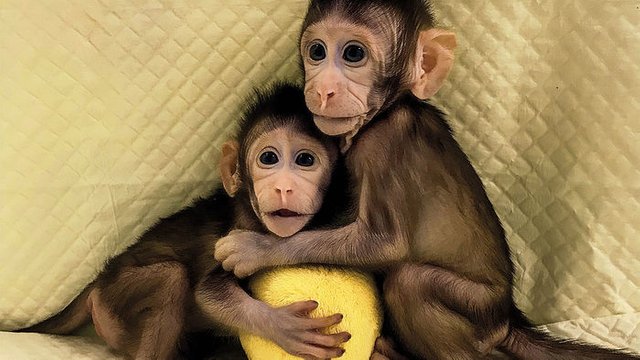Paper discussion #4 – The Cloning Revolution
Do you remember Dolly the sheep? The first mammal to ever be cloned. If you think a sheep was impressive, researchers in China have now cloned the first monkey, and not just that... They are twins! Meet Zhong Zhong and Hua Hua.

Figure 1: Zhong Zhong and Hua Hua, identical monkeys.
Why clone?
It took 20 years since Dolly, but now two identical long-tailed macaques have been cloned. During this time 23 mammalian species have been cloned. Some examples besides sheep are mouse, cattle, pig, cat, dog, and rat. While it is technologically impressive that we as humans have the ability to clone animals, why though?
Besides bragging rights, cloning is useful because of two key concepts in science.
- When you are doing experiments you want to have one variable parameter. All the other parameters should stay constant so that whatever you measure is due to the change of that one variable parameter only.
- The sample size should be large enough to give a reliable result.
If you are doing physiological research or testing new treatments on animals, and let’s say you are using 100 animals, then all those 100 animals will have a different genetic makeup. So much for keeping your parameters constant right? The solution is to use 100 animals that have an identical genetic makeup: Clones. The reason why the successful cloning and growth of these monkeys is so important is because monkeys are primates like us. They are physiologically comparable and this makes them highly valuable for research purposes.
Method of cloning
The monkeys were cloned with a technique called Somatic Cell Nuclear Transfer (SCNT). To explain how this technique works it is first good to know what a somatic cell is and what a nucleus is.
- A somatic cell is a non-reproductive cell, which means any cell beside sperm or egg cells.
- A nucleus is a compartment in the cell that holds the genetic code or DNA.
It sounds like the technique transfers the nucleus of a somatic cell. But to where? First, you take a fresh egg cell and take the nucleus of the egg cell, secondly, you transfer the nucleus of the somatic cell to the empty egg cell. Simple copy and paste right? Now the new egg cell can be placed in a surrogate mother monkey, who can give birth to the cloned baby monkey (Figure 2).
Figure 2: The cloning procedure of SCNT – Zhen et al. 2018.
Actually, it is a lot more difficult than it seems. The hard part is to successfully get the surrogate mother pregnant. The authors found a way to approach this. I can tell you they injected H3K9me3 demethylase Kdm4d mRNA and did a treatment with histone deacetylase inhibitor trichostatin A before they placed the cell in the surrogate mother, which improves blastocyst development and increases pregnancy rates. But really, what does that even mean? Let me unpack the previous sentence:
In essence, the somatic cell nucleus needs to be reprogrammed to fit and develop into an egg cell. Reasons, why this wouldn’t happen are called ‘undefined reprogramming defects’. One study by Matoba et al. (2014) found that H3K9me3 causes such defects. The mRNA added by Liu et al. removes H3K9me3 and increases the chance of successful pregnancy.
DNA hypermethylation, which is a process that alters the activity of DNA segments, causes errors in DNA expression. A study by Kishigami et al. (2005) showed that DNA hypermethylation can be reduced by a treatment with trichostatin A.
Conclusion
It is an amazing technological achievement that the monkeys have been cloned. It is even more impressive when you realize that this technique can also be used to clone humans. Although, ethical objections will prevent that in the near future. I haven’t really discussed the ethical issues in this post because I wanted to focus more on the technology.
What do you think though? Cloning humans? Yes, or no?
This post was a discussion based on the following paper:
Liu Z, Cai Y, Wang Y, Wang Z, Poo M, Sun Q, et al. Cloning of Macaque Monkeys by Somatic Cell Resource Cloning of Macaque Monkeys by Somatic Cell Nuclear Transfer. Cell [Internet]. :1–7
National Geographic also made a nice video of the news:
References:
Sciencemag
The Life of Dolly
Somatic Cell Nuclear Transfer
Images:
Zhong Zhong and Hua Hua
Recently from @Altherion
Supplements #1: Echinacea
Paper discussion #3 - A prevention for cancer?
The Farmer's Friend
Urban Farming
by FoodLabScience
Twitter

A scientist’s food for thought!

Being A SteemStem Member
technically yes, but there's a problem here too. If all animals you test a compound on are clones, they might be the carrier of a single gene that causes a different reaction.
So if you're unlucky, u'll draw completely wrong conclusions.
The main reason why we have to use so many animals during a study is that we have to vary the genetic material. Having 100 identical animals is a biological n=1, and you end up with only technical replicates.
I'm sure there are types of studies where you want to exclude genetic variation. In pharmacology/toxicology though, we need it.
Edit: By the way, very good post, I enjoyed reading!
Good point! I agree that for some studies the genetic variation is valuable in itself.
Although, when you are doing these studies, is the genetic variation the variable parameter or is dose as well? For example, in a pharmacology study with 100 monkeys, do you use the same dose to test the average effect of the drug on a large variety of genetic makeup? I would argue that testing dose-response testing would benefit from cloned subjects.
Additionally, I predict it would be possible to prescreen the DNA-to-clone for a gene that can cause substantially different reactions. Although, this is purely hypothetical.
Great input @sco!
when you vary the dose, you take groups of animals that receive the same dose. You're right, with clones you would probably need much less animals here. But even so, you would have to test at least one concentration with different animals in addition to that, lest you risk the effect described above again.
But this could - in the end - result in less used animals, depending on the design of the study. Great thought!
That seems particularly unnerving - but only because the young of this particular species of primate looks a hell of a lot like a demon wearing an evil mask. (Although I guess cloning applications in animal testing aren't ideal either, although I can see why it might be useful)
There are a lot of ethical problems involved in cloning technology. The authors admitted that even though they followed international guidelines, cloning of non-human primates is more accepted in China than anywhere else. I think people find it creepy because of the idea that we humans are playing God by creating copies of organisms.
That's definitely a big part of the generally negative attitude - personally, I don't have any problem with that whatsoever - the idea of us "playing god" - but there is something unseemly about learning to clone complex mammals and then using them for lab tests, or eating, or organ growing. If you're a fan of the Dune series, it's reminiscent of the Bene Tlelaxu - just gives me the heebie jeebies. Having said that, next thing you know they'll be cloning me to get me a new lung or something and, who knows, I might jump at the opportunity.
After finding this news and reading the original journal paper, few things came to my mind:
Accordingly to the summary of published report in the journal Cell [1], authors say “We found that Injection of H3K9me3 demethylase Kdm4d mRNA and treatment with histone deacetylase inhibitor trichostatin A at one-cell stage following SCNT greatly improved blastocyst development and pregnancy rate of transplanted SCNT embryos in surrogate monkeys. For SCNT using fetal monkey fibroblasts, 6 pregnancies were confirmed in 21 surrogates and yielded 2 healthy babies.”
Genetic analysis was done to confirm the origin of monkey from the original donor cell and egg of monkey.
Some Interesting Statistics:
In this study, total of 63 female monkeys were used as test surrogates. Out of 63 surrogates receiving SCNT embryos, only 28 became pregnant (44.5% success rate). Out of 28 pregnancies, only 4 resulted in live births, where only 2 offspring survived. That is only a 7.1% success rate within the sample and 3.17% success rate in the whole population of 63 female monkeys used as test surrogates. In other words, the way this study was designed, the overall SCNT success rate was only 3.17%!
Ethical issues:
It would be almost impossible to do this kind of study (N = 63 total monkeys) in the U.S due to ethical issues. There are several viable alternatives to using monkeys for SCNT research. It may be simply that doing research on monkeys is easier in China and do not require stringent approval and justification. Moreover, since the SCNT embryo transferring method works on monkeys, it will likely work on humans too! It common for us to think: will it ever be tested on humans?
[1] http://www.cell.com/cell/fulltext/S0092-8674(18)30057-6
You got a 1.70% upvote from @postpromoter courtesy of @altherion!
Want to promote your posts too? Check out the Steem Bot Tracker website for more info. If you would like to support the development of @postpromoter and the bot tracker please vote for @yabapmatt for witness!
This post has received gratitude of 2.54 % from @appreciator thanks to: @altherion.
Sneaky Ninja Attack! You have been defended with a 9.24% vote... I was summoned by @altherion! I have done their bidding and now I will vanish...Whoosh